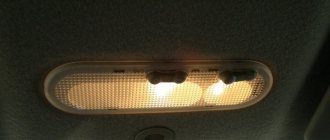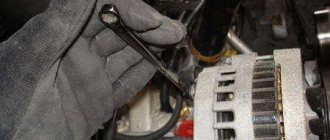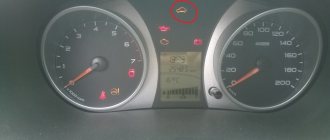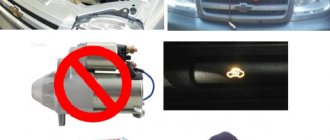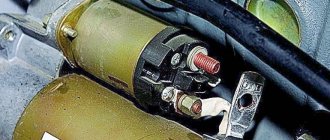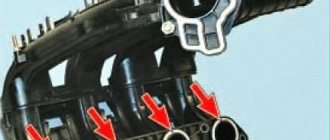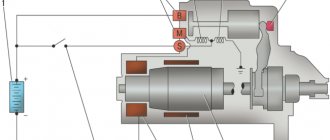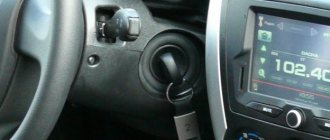To find out why the starter clicks but does not turn, it is necessary to disassemble its structure and switching circuit, including the components on which its operation depends. Let's divide the entire structure that interests us into three elements: the power system - for the starter, this is, first of all, the battery; switching – all connections (wires and relays); the starter itself.
OPTION ONE – Battery
This is perhaps one of the most common types of malfunctions of this kind. Its essence lies simply in a discharged or inoperative battery. It is easy to determine if the battery is discharged: if the solenoid relay clicks, but the starter does not turn, and the lights on the dashboard go out, the culprit is the battery; when a series of clicks occurs, and the lamps also noticeably dim, then, as in the previous case, the battery is to blame; if nothing happens at all, then the battery may also be discharged - you need to check it with other loads (for example, turn on the headlights). If the cause is the battery, then it would seem that everything is simple - just charge it (or light it) and you can hit the road. But not everything is so simple, because the unclear reason that caused the consequence in the form of an unsuccessful launch will cause the same consequence again. Therefore, it is worth figuring out why the battery was discharged.
Battery discharge. Why?
Everything is elementary if a light was simply left on somewhere, or another consumer was left on. But if everything was turned off, then it is necessary to check the quality of the generator, as well as the serviceability of the battery itself.
SWITCHING
Switching the starter is simple - the plus of the battery is screwed to the solenoid relay, the minus is on the housing, and for starting, a small cross-section wire from a typical relay, which is controlled by the ignition switch, is suitable.
RELAY
If, when you turn on the ignition, the relay clicks, but the starter does not turn (and the solenoid relay also does not work), then the reason may be in the relay itself or the control cable. You can accurately install it in a fairly simple way - you need to apply “+” power to the starter control terminal (where the cable of the smallest cross-section is connected, shown with an arrow in the photo). how to check the relay and wiring If the starter starts to “turn”, then the reason is in the wiring, relay or ignition switch. Note. Before checking, you must make sure that the car's gearbox is in neutral, otherwise the car may start moving. By the way, if the trip is urgent, then you can start the engine this way. You just need to turn on the ignition and manually (by applying positive power to the control terminal) start the engine.
BAD CONTACTS
If the starter clicks but does not turn and, at the same time, extraneous sounds occur (as an option, it sometimes clicks, sometimes it does not click) - you need to check all connections, especially the power cable. The point here is that when starting the engine, the starter consumes quite a lot from the battery - about 200 amperes. If the contact is insufficient somewhere, then out of the required 200 it can “get” only 10, which is enough for the solenoid relay to operate, but not enough to start. In the same case, a series of “clicks” may occur. It is necessary to check all connections (including battery terminals), clean the contact pads from oxides, lubricate them with special lubricant and tighten to the recommended torque.
MALFUNCTIONS OF THE STARTER ITSELF
Typically, this type of malfunction cannot be eliminated without dismantling the unit.
But it is possible, relatively accurately, to find out the reason. Let's consider the electrical part of the starter, which includes: windings; brush assembly; solenoid relay. Let's consider them in descending order of probability of failure. RETRACTING RELAY
So, if the starter clicks once, but does not turn, you should check the retractor relay.
To do this, you can try to run the starter bypassing its switching. There are three terminals on the solenoid relay - two of them are the largest (one is the input from the battery, the second is the output to the starter itself) and one is small, the control one. You will need a suitable tool - a screwdriver or a wrench, which can securely close two large terminals (arrow in the photo) for a short period of time, and it is necessary that the selected tool does not touch the body (any metal parts under the hood). how to check the solenoid relay If, when the terminals are closed, the starter begins to rotate (possibly with a bang), then the solenoid relay is to blame. Note
:
You should not start the engine this way, because... The starter drive gear does not engage. The point here is that inside the relay, the contact pads were simply “burnt”, and a dielectric layer of metal oxides formed on them. Given the high operating current, the contacts can “burn out” in one start attempt. There are two solutions
- you can disassemble the relay and clean the contacts, or replace it. The second option is much better, because such repairs will last longer. This is due to the fact that in production the contact pads are covered with a special layer of an alloy of non-ferrous metals (with the inclusion of “noble”), which reduces electrical erosion and the likelihood of oxidation. Having cleaned them, this layer will be missing, so such a relay will not work for a long time.
BRUSH UNIT
If it comes to checking the brushes, then you cannot do without dismantling and disassembling the starter. It is during disassembly that the wear of the brushes will be immediately visible. This can be indirectly determined by a long period of operation, because The resource of the brush assembly is quite large. It is worth noting that in some design options, if the brushes are faulty, the retractor relay may also not operate. Those. If the retractor doesn’t “click” and the starter doesn’t go straight, then the brushes may well be to blame.
WINDINGS
Failure of the windings can give away their color and smell. Naturally, this will become visible when disassembling the starter, and, in many cases, it will be easier and more reliable (and sometimes cheaper) to replace it entirely. In general, the symptoms are similar to a malfunction of the brush assembly.
The starter clicks but does not turn, what is the reason?
Good afternoon.
Many car enthusiasts are familiar with the situation when the starter clicks but does not turn. As luck would have it, such situations occur at the most inconvenient moments, for example, at gas stations or when leaving for work. In today's article, we will tell you how to determine the malfunction and, if possible, start the car to get to the repair site.
Before telling the troubleshooting algorithm, let's look at the starter device. For clarity, watch this video:
As you can see, the starter is a regular DC motor and relay. When you turn the key in the ignition and hear a click, it is the solenoid relay that clicks (the coil and contacts at the top of the screen in the video). If the starter does not rotate, but clicks, the following options are possible:
- The battery is dead.
- starter relay failed
- The contact coins in the solenoid relay are burnt.
- The starter brushes are worn.
- the starter armature is jammed.
- power plus is not supplied to the starter (because if there is no mass there will not even be retractor clicks)
Below we will analyze each of these faults in detail, and tell you which faults will allow you to start the car on the spot, using the existing starter, in order to get to the service station.
A severely discharged battery is the most common cause of clicking noises when turning the ignition key.
The error looks like this:
In our video you can see that when starting, at first, the starter barely turns the engine, and then it just crackles…. If the battery is severely discharged, the starter will not even try to crank the engine but will immediately make nasty clicking noises.
The fact is that the battery voltage is not enough even to operate the solenoid relay!
Options to solve the problem:
- light a cigarette from another car (we have a separate article about this on our website).
- start the car from a pusher/tug (if it has a manual transmission).
- remove and charge the battery.
Your starter is working!
Starter relay failure.
Relay failure manifests itself as a quiet click when turning the key.
In this case, you can start the car using a simple screwdriver. This is done like this:
Attention! If you are not confident in your abilities, you should not do this. It is better to contact specialists or call a tow truck. If you make a mistake when starting this way, the vehicle may move unintentionally or catch fire due to a short circuit.
Vehicle with manual transmission:
- set the parking brake.
- turn on neutral gear.
- open the hood and prepare a flathead screwdriver.
- turn the key in the ignition switch to the ignition on position.
- Using a screwdriver, we close two contacts on the solenoid relay (as in the video).
- After starting the engine, remove the screwdriver and drive to the repair site.
Car with automatic (+variator and robot) gearbox:
- install a car parking brake (for robot and variator).
- open the hood and prepare a screwdriver (possibly two).
- turn the ignition to the on position, press the brake, move the gear selector to the parking position (P).
- Using a screwdriver, we close two contacts on the solenoid relay (as in the video).
- After starting the engine, remove the screwdriver and drive to the repair site.
The contact coins in the solenoid relay are burnt.
This malfunction manifests itself in the form of loud clicks when the key is turned to the start position and the key is released. In some cases, the starter may trip.
Here is a video example of such a malfunction:
How to quickly diagnose contact patches?
Everything is extremely simple - open the hood, take a screwdriver, and bridge these two terminals:
If a spark jumps when the connection is made and you hear the sound of the electric starter rotating, you can be sure that your contact pins are burnt.
In this case, the car can be started with a screwdriver!
How to start a car with the starter when the contact pins burn?
Attention! If you are not confident in your abilities, you should not do this. It is better to contact specialists or call a tow truck. If you make a mistake when starting this way, the vehicle may move unintentionally or catch fire due to a short circuit.
In order to start the car when the contact pins burn out, you must simultaneously bridge all three contacts on the solenoid relay.
Closing the two contacts under the nuts is necessary to rotate the armature, and closing the control contact so that the overrunning clutch (Bendix) engages with the flywheel.
The procedure for starting a car if the contact pins fail:
Vehicle with manual transmission:
- set the parking brake.
- turn on neutral gear.
- open the hood and prepare a flathead screwdriver.
- turn the key in the ignition switch to the ignition on position.
- Using a screwdriver, we close all three contacts on the solenoid relay (sometimes one screwdriver is not enough and you have to take two).
- After starting the engine, remove the screwdriver and drive to the repair site.
Car with automatic (+variator and robot) gearbox:
- install a car parking brake (for robot and variator).
- open the hood and prepare a screwdriver (possibly two).
- turn the ignition to the on position, press the brake, move the gear selector to the parking position (P).
- Using a screwdriver, we close all three contacts on the solenoid relay (sometimes one screwdriver is not enough and you have to take two).
- After starting the engine, remove the screwdriver and drive to the repair site.
The starter brushes are worn.
The malfunction manifests itself in the same way as burning of the contact coins (loud clicks when turning the ignition key), the only difference is that when the brushes wear out, the starter will never rotate.
This is checked in the same way when bridging the contacts of the solenoid relay with a screwdriver.
Clicking sounds are heard, but the starter does not turn due to the windings or brush assembly
If the battery, ignition switch, contacts, wiring and starter relay are checked, but it still does not rotate when you turn the ignition key, then the problem is directly in the starter. In such a situation, you will have to completely remove it from the car, disassemble it and evaluate the possibility of repairs. You can also simply replace the starter with a new one.
If you decide to repair the starter yourself, know that the problem with it refusing to rotate under load may be due to:
A faulty brush assembly, the wear of which is easily determined visually.
Starters are rarely repaired, and such a step should only be taken as a last resort. If it is possible to replace the starter, then it is better to do this than to bother with repairing the winding or brush assembly.
Source
Immobilizer
If the car refuses to start, then this is one of the possible reasons. You can notice problems in the operation of this system yourself. If the corresponding icon blinks on the dashboard and a characteristic beeping sound is heard, then you should read the operating instructions. If the Lada Kalina does not start, the immobilizer is a common problem. The problem is not easy to fix. In the instructions for the car, the manufacturer indicates the decoding of sounds and blinking lights - the car owner needs to count the time between flashes, the number of buzzer signals, and then read what the manufacturer writes about this.
How and why the immobilizer fails
Let's dwell on this topic in a little more detail. The thing is that the ECU controller on this model is located under the heater radiator. In second-generation models, the controller was moved.
First of all, when exposed to liquid, the output switch burns out. The chip can be re-soldered, but after such repairs the problems will go away for literally two months, and then they will appear again. The heater radiator will need to be replaced. If this problem exists, then experts recommend installing a new controller between the engine compartment partition and the stove.
Now about the immobilizer - in Kalina cars the manufacturer installs APS-6 immobilizers. In very rare cases, these devices fail on their own. Often, the problem is hidden in the wiring or control panel. The key fob body is held together with one self-tapping screw - the screw can be overtightened or undertightened. A crack appears on the remote device chip between the transponder contacts. In this case, if the Kalina does not start, only a spare or training key, or replacing the remote control will help.
Starter
The immobilizer has been checked and does not give any alarms, but the engine still does not want to start. Another reason for this behavior is the starter. It’s easy to notice a problem with the starter – you won’t hear the characteristic sound of the engine starting. The mechanism simply does not spin, which means the engine will not be able to start. Everything is clear here - you need to remove and check the starter.
If the Kalina does not start, the starter does not turn, then the first reason may be the battery. It may simply be discharged. If the lights in the cabin and on the dashboard are not lit, the driver will be able to immediately notice this. However, it often happens that everything is in order, but the starter still does not work. For diagnostics, turn on the high beams and get out of the car. Dim headlights are due to the battery. It is discharged, but only to a critical level, when there is not enough power to turn the starter.
If the Kalina does not start, the starter does not turn, the best way out of this situation is to charge the battery. But if the headlights are bright in high beam mode and are not going to dim, then you will have to look for the reason elsewhere.
When the starter is turned on, all devices are turned off.
If, when the starter is turned on, all devices turn off, this cannot be attributed to a starter malfunction. In this case, it is necessary to check the state of charge of the battery and the reliability of the terminals on it. The easiest way to do this is with a voltmeter, measuring the voltage when the starter is turned on. If the voltage drops below 9V, the battery may not be charged enough or the starter may be faulty. To check the charge, just turn on the high beam headlights and if the voltage begins to drop sharply, then the battery is discharged. If the voltage does not drop sharply, then the starter is faulty.
To check the contact in the terminals, it is necessary to measure the voltage on them. If necessary, remove and clean the terminals.
Starter or wiring problems
You can use a multimeter to test the wiring. The red wire is connected to the starter contact, the black wire to ground. In a normal situation, the device will show from 12.5 to 14.5 V. If the reading is less or even zero, then there is something wrong with the wiring.
The first step is to clean the contacts, check the integrity of the wires and fuses.
This is another popular problem when Kalina does not start. ECUs are the “brains” of the car; they themselves are quite reliable, and if you don’t touch them, then no problems will happen. However, most often the ECU is flooded.
This often happens when antifreeze leaks. This has already been discussed in the section on the immobilizer. When installing an alarm system or when pulling car wires, they forget to install the plugs - water gets into the ECU. Repairing an electronic unit is a futile task.
Gasoline pump
The vagaries of the fuel pump are often observed, especially in winter. The starter works, but the Kalina car refuses to start, the fuel pump cannot be heard, and an exclamation mark may flash on the dashboard.
First of all, check the pressure in the fuel system. To do this, open the hood and look for the cap on the ramp with the injectors. You can see the nipple there - if you press it, fuel should spray out. If it splashes, then the problem is not with the fuel pump.
Another reason is the relay. There is a cover in the transmission tunnel on the passenger side. It contains power coils. To eliminate the malfunction, just knock or warm them up.
Why Lada Kalina does not start, the starter does not turn and what to do
In this article we will look at the questions of the happy owners of one of these creations - Lada Kalina - namely, why this car may not start.
In fact, there are enough reasons why the Lada Kalina may not start. We will deal only with those reasons that can be eliminated independently, while the rest will require the intervention of trained specialists.
Even the most ordinary driver without technical education can fix the slightest malfunction in a car; the main thing is to be able to hold a wrench correctly in his hands.
The most common problems
Now let's look at the most common reasons why the engine in a Lada Kalina may not start:
- Immobilizer. The first and most common reason why the engine does not start is the failure of the immobilizer. It’s not difficult to fix such a problem - just replace it. However, everything would be fine if this problem did not have its own nuances. If the immobilizer starts beeping and the light blinks, sit down and study the hardware.
As a rule, the vehicle's operating and maintenance manual contains a description of the buzzer and the signals produced by the light bulb. You will need to remember the issued Morse code and find information about the problem in the instructions.
In cold weather, a problem often arises when the Kalina engine starts the fifth or sixth time.
In most cases, to solve this problem you will need to “relearn” the key. This procedure is also described in detail in the manual, so let’s move on.
- Starter. If all the issues with the immobilizer are resolved and it no longer gives alarm signals, but your Kalina still does not want to start, the reason may lie in the starter.
This problem is easy to notice: when you turn the key to the “Start” position, the Lada Kalina does not start and does not turn the starter.
In this case, there are no signs that you are starting the car. Only a deaf person might not notice such a problem. The first thing you should check is the car battery. The power supply is probably low.
If the lights in the interior of your car do not light up when the ignition is turned on, and the dashboard does not light up, there is a problem. Charge or change the battery. But if everything described is in order, and the starter does not turn, turn on the high beams and get out of the car. Pay attention to the headlights. If the light from them is dim, this indicates a low charge of the power source, and there is not enough of it to start the starter. The solution to this problem is to charge the battery.
If the battery problem doesn't fit your situation, you'll have to get your hands dirty. There may be two problems:
- faulty wiring;
- the starter has failed.
To check the wiring, you will need a tester and a minimum understanding of how to work with it. We connect the red probe of the tester to the contact on the starter, and connect the black probe to the ground of the car. In current measurement mode, the tester should show from 12.5 to 14.5 volts.
If the tester readings are lower, we are looking for a problem in the wiring. Visually inspect the wires for breaks, breaks, or abrasions. We protect the contacts with sandpaper and check the corresponding fuses. If we find a problem in the wiring, we fix it, otherwise your swallow is welcome to the service station.
- Electronic control unit. In Lada Kalina, quite often the problem can be hidden in the electronic control unit (ECU), or, as it is also called, “brains”. As a device, an ECU is a fairly reliable and trouble-free part, but until you get your hands on it again. After unsuccessful intervention by the technician, quite often the electronic board in the “brains” floods this device. For example, due to the fact that after installing an alarm or something else, when pulling wires into the car interior, the technicians forget to put the plugs in the ECU in place or do not close them tightly. After this, for example, antifreeze from the heating system enters the ECU housing, since the ECU is located under the radiator.
If the electronic control unit fails, repairing it is a waste of time and money. In most cases, if the ECU breaks down, all that can be done is to replace it with a working one and move it to another place, protected from liquids and water.
We fix starter malfunctions on Kalina ourselves: expert advice
It is important for any driver that his car starts with a half turn of the key.
To start the engine, a gear starter is installed on the Lada Kalina. If Kalina does not start, the starter does not turn when you turn the ignition key (KZ), then the device that starts the power unit is faulty. The article explains what problems are possible and how to do the repair yourself. Starter for car
If the Lada Kalina does not start, the following typical malfunctions are possible:
- when starting the power unit, all devices do not work;
- when the short circuit is moved to the start position, the starter does not turn on;
- the starter does not turn on the first time;
- the starter turns, but the crankshaft does not turn;
- When starting up, the device rotates slowly.
If after starting the engine all the instruments go out, this means that there is no power supply. You should check the terminals and state of charge of the battery. If after starting the starter does not work, then you need to check its serviceability (the author of the video is Expert R).
It is better to start troubleshooting without removing the device from the car. First, use a screwdriver to connect the solenoid relay bolts at the top and bottom. As a result, the electric motor should start working, but without rotating the crankshaft. It should rotate freely, and there should be no extraneous sounds or noises.
After checking the electric motor, you need to remove the wire from the control terminal of the traction relay and bridge it and the upper bolt with a screwdriver. After switching on, the engine crankshaft should begin to rotate. If everything works fine, you need to look for the fault in the retractor circuit.
First you need to check the trigger relay located in the mounting block, replacing it with a known good element. If the starting device works, then you need to replace the faulty relay. Otherwise, you need to check the power circuit. To do this, insert a jumper into sockets 87 and 30.
Mounting block Kalina
When you turn the key ZZ, the engine should start, otherwise you should check with a test light whether 12V voltage is supplied to socket 30. One end of the test light should be touched to terminal 30, and the other should be connected to ground. The light should be on. Otherwise, damage to the current-carrying path may occur.
If the circuit is not damaged, we check the contact group 33 by connecting the ends of the test lamp to connectors 85 and 86. If, when starting the engine, the light comes on, this indicates that everything is in order with the contact group. Otherwise, it will need to be repaired.
Replacing the traction relay
The retractor is checked for serviceability by connecting its bolt located on top to the control terminal. When closed, the relay should operate. Otherwise, check the battery charging and the condition of its terminals. If the traction relay is broken, it should be dismantled and check whether the windings are working properly. If the relay is in working condition, you need to check the wear of the brushes.
If after starting the starter does not turn and the engine does not start the first time, then the traction relay needs to be replaced. It is possible that the reason is burnt contacts on the electric motor. If the device turns on but rotates slowly, you should check the voltage at the battery terminals with an ohmmeter. For successful startup, the voltage should not be lower than 9V. Otherwise, repairs are needed. The cause of the problem may be bushings, brushes, or the stator magnet may have fallen off.
If the starter spins but the crankshaft does not rotate, then the device requires repair. In this case, the following malfunctions are possible: the bendix rotates, the flywheel crown is weakened, the textolite gear of the gearbox is broken.
DIY mechanism repair
If the mechanism does not work, it must be removed. To do this, you need an open-end wrench set to “13”.
1. The process of unscrewing the fastening bolts 2. Dismantling the mechanism from the car 3. New mechanism for replacement
The removal procedure consists of the following steps:
- First, remove the negative terminal from the battery.
- Then we dismantle the air filter.
- Next, disconnect the traction relay control wire.
- Now you need to disconnect the power cable. To do this, move away the protective rubber cap, under which there is a positive wire.
- Then unscrew the nut that secures the power cable.
- Disconnect this wire, as well as the wire located nearby.
- Next, unscrew the nuts with a “13” wrench that secure the starter. Two are located on top, and the third can be felt with your hand below.
- After unscrewing all the nuts, you can remove the device from the studs.
Further actions depend on the condition of the starter. It is either repaired or replaced. Repairs will require disassembling the device. If a replacement is needed, a new part is purchased. Installation is in the reverse order.
Conclusion
The Lada Kalina starter is a reliable device made of grades of steel that can withstand any weather conditions well. If you use it correctly, it will last a long time.
It is permissible for it to operate for no more than 10 seconds; during further operation, the device will overheat. The cost of repair depends on the breakdown. You can disassemble the starter yourself, saving on a visit to a service station, and replace the damaged part. It’s easier, although financially more expensive, to buy and install a new starter.
Video “Possible starter failures”
This video demonstrates how to check the starting device (the author of the video is Ivan Matieshin).
The starter clicks but does not turn
For a modern person, a car is no longer considered a luxury; it is a means of transportation, a way to make money. Problems often occur while driving. Car owners need to know some nuances in the operation of the car. Sometimes you have to fix some problems yourself. Everyone knows that the main unit of the engine starting system is the starter. Its task is to spin the motor shaft to the starting speed. But it often happens that the starter clicks but does not turn. This problem can be dealt with. There are quite a few reasons to be aware of. But first we need to find out what it is.
Device
The starter is a complex electromechanical unit. Without it, any car, be it Nexia, Kalina, Priora or others, will be an ordinary pile of iron and if it works poorly, any car will always take a long time to start. You can come up with other ways to somehow start a car, but this will turn out to be a whole adventure. It happens that you need to start the engine, but the starter clicks, but does not turn. There are many reasons, and most often it is that the battery is barely charged. More often than not, the car barely starts in cold or hot weather. And first you need to know that the starter consists of:
- Lids;
- Windings;
- Anchors;
- Housings;
- Collector;
- Brushes;
- contact bolt;
- Contact disk;
- Traction relay windings;
- relay housings;
- Core;
- Lever;
- Axles;
- Drive mechanism;
- Thrust washer;
- Eccentric flange;
- Driven ratchet with gear;
- Rusk;
- Pin;
- Cone;
- Drive coupling half;
- Springs;
- Drive mechanism housings;
- Guide bushing;
- Spring ring.
Broken bushing
On models of modern cars, and this applies to the following: Priora, Nexia, Kalina and others, starters are equipped with remote control. The main elements are: DC electric motor, electromagnetic traction field, drive mechanism.
There is such an element on the Priora car or other models as a traction relay or it is also called a retractor relay. It resembles a small cylinder that is attached to the base of the starter. On the relays of the Kalina or other cars, there are retracting and holding windings. The starter does not turn or fails when there is a voltage deficiency on the holding winding and it barely retracts the core. Only it returns to its previous position and it is impossible to hold the holding winding. This happens when you need to start a Kalina or Priora car, or others, and especially in cold or, conversely, in “hot” weather by turning the key in the ignition. The clicking sound is produced by the solenoid relay and there are several reasons.
Troubleshooting methods
If the check reveals a short circuit, it is easier to immediately replace the part with a new one. To restore normal conductivity on the “nickels” and correct a break in the holding winding at the fastening point, disassemble the spare part, desolder the terminals, clean the copper from oxide, reassemble, and tighten the fasteners.
Depending on the manufacturer and year of manufacture, the solenoid relay comes with a detachable housing (the cover of the power contacts is secured with screws) and with a one-piece housing (rolled into the metal of the housing). Diagnostics of both types of parts can be carried out without opening them, but there is a problem with repairs: with “one-piece” parts, the body is very difficult to assemble neatly and can easily be damaged during assembly. A cracked cover is unsuitable for further use. If you have little experience in fine work with electromechanical devices, it is easier to purchase a new, known working relay.
Main reasons
If you are wondering why the starter does not turn, then you need to know that the reasons may be as follows:
- There may be a problem with the battery, but the battery itself is fine. Often it is because of this that the car takes a long time to start. It's probably just flat or barely charged. Sometimes it happens that the terminals have poor contacts with the wires. In this case, you need to charge the battery and try to start the engine again, but you shouldn’t overexert yourself for a long time in “hot” weather to avoid overheating;
- If the ground with the motor is not quite good, then you need to use another ground wire and try to start the motor again.
When the work is done and the car takes a long time to start again, you should inspect the car more carefully. If the starter does not turn, but a click is heard clearly, then you need to pay attention to the weight of the engine and check how the traction relay is attached to the starter housing. The cause may be bad or burnt out contacts. This sometimes happens on the starter of a Kalina car. If everything is normal, then most likely there is a malfunction of the mechanism itself, and then the starter will have to be completely disassembled or replaced.
Bendix
Spark plug
If everything is in order with the electronic filling, you should look for the problem in the candles. Often, and especially in winter, spark plugs flood.
Compression in the engine in cold weather does not meet the standards, so the engine may not start immediately. Often flooding of spark plugs occurs due to a discharged battery, which is unable to produce a normal spark. If not, the reasons may also be in the wiring or the spark plugs themselves. The easiest way to dry the spark plugs is to press the gas to the floor and crank the engine with the starter two or more times. Often, after this the car will start. If this does not help, then for more thorough drying you should dismantle the spark plugs, then clean them, check the gap, and then dry them with a hairdryer or in the oven.
Other reasons
If the starter does not turn and the car barely starts, but you are sure that the problem is not in it, then the possible reasons are the following:
- The power wire, which is responsible for connecting the starter winding and the traction relay, has burned out;
- The starter brushes and bushings are badly worn;
- The starter winding has broken or the armature has shorted on the winding;
- The fork in the Bendix drive is deformed or destroyed.
It happens that the starter turns idle and the car takes a long time to start. The reasons may be the battery and it is barely charged. This happens in cold and hot weather. Sometimes you need to recharge the battery and try to start the car again.
It often happens that the engine in a Priora, Kalina, or other car does not turn the starter well, and the car takes a long time to start. The possible reasons for this situation are:
- The motor bushing or shaft is jammed;
- The rotor engages the “plus” of the stator;
- The winding is short.
At one glance, no matter how hard you try, you won’t be able to detect the problem, especially in cold weather. In “hot” or hot weather, you need to let the car cool down a little. The starter will need to be removed.
But sometimes you can do a lot yourself:
- If, however, the problems are related to the shaft, then it is necessary to tighten it or, in the worst case, replace it;
- Bushings are changed only as a last resort, if they are severely deformed;
- If the problem is that the rotor is rubbing against the stator, then the shaft needs to be aligned;
- You can determine whether the contacts are shorted or burnt by the smell and the appearance of black spots.
Rotor (armature)
Emergency engine starting methods
When the starter does not click or make any sounds at all, the engine can be started if it is closed “directly”. This is not the best solution, but in cases where you need to go urgently and there is no other option, you can use it.
Let's consider the situation of how to start the engine directly using the example of a VAZ-2110 car. So, the sequence of actions will be as follows:
After this, install the chip and air filter back. An interesting fact is that in most cases the engine will continue to be started using the ignition key. However, you should remember that the breakdown still remains, so you need to look for it yourself or go to a car service center for help in order to fix it.
Emergency engine start
We offer you another method that will be useful to you if you need to start the engine in an emergency. It is only suitable for front wheel drive passenger cars with manual transmission! The algorithm of actions is as follows:
The described method of spinning the wheel of front-wheel drive cars is reminiscent of the method of starting a crooked starter (using the crank) used in old rear-wheel drive cars (for example, VAZ “classic”). If in the latter case the starter is spun using a handle, then in front-wheel drive cars it is spun from the axle shaft on which the raised wheel is located.
Conclusion
The starter is a simple but extremely important mechanism in a car. Therefore, its failure is critical , as it does not allow the engine to start. In most cases, problems are related to the car's electrical wiring, poor contacts, broken wires, and so on. Therefore, if the starter does not turn over and does not start the engine, the first thing we recommend is that you inspect the contacts (main ground, relay contacts, ignition switch, etc.).
Any car engine is started using a starter. The use of this electrical unit allows you to start the power plant without any effort on the part of the driver - simply turn the ignition key to the desired position.
Despite the fact that many brands of cars of different classes are produced, the design and principle of operation of the starter are identical (the only difference is in size and some design features). And this, in turn, affects malfunctions - they are all the same for any model.
One of the most common problems that many car enthusiasts face is the starter not working. That is, the driver turns the key, and in response hears only one or several clicks, but the mechanism itself does not start working.
